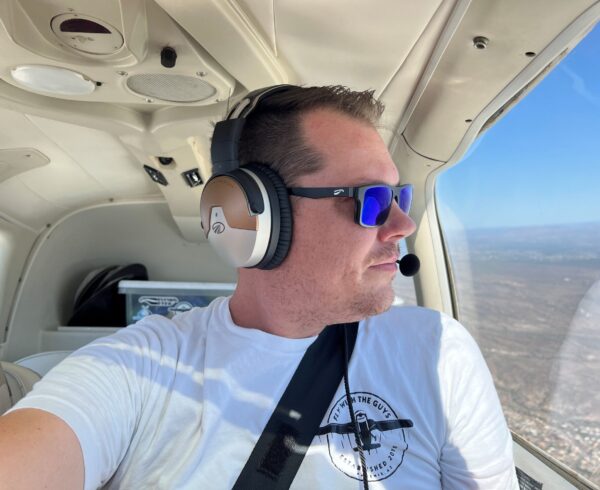Every experienced pilot is tuned to the sounds of their aircraft, what’s normal and what’s not. An unusual sound can be the first warning that something is wrong, sometimes even before engine or flight instruments show a problem. So, you don’t want anything to interfere with your ability to hear what’s happening with your craft.
We’re often asked whether Active Noise Reduction (ANR) in headsets can interfere with a pilot’s ability to hear the aircraft when they should. The answer from veteran pilots is, “No.” In fact, experts we talked to said that by filtering out the constant background engine noise, their headsets actually make it easier to hear unusual noises that could indicate trouble.
Zoan Herclerode has been in love with flying since she was 16 years old. After seeing her husband through grad school, she set out to become a career flight instructor. She was AOPA’s National Best Flight Instructor in 2017. She flies out of Colorado Springs and is also an assistant chief instructor for a military aero club there. Zoan appreciates how her Zulu 3 ANR headset cancels the low frequencies of her Piper Lance’s engine and other aircraft she flies. “It takes out that big drone, that deep, dark hum that’s really fatiguing and annoying. In the Excel, when I turn on the bleed air section in the APU, it’s just obnoxiously loud. It’s really nice just to tune that out.” But she says she can still hear if there are problems. “I can absolutely still hear the engine. When you first start the piston airplanes, you can hear the starter Bendix engaged until it gets to 500–700 RPM. I can also distinguish between engine noise and airframe noise. Is it a thumping of a strap on the frame or the clump of a tire? One time, I heard a clunk and it turned out I had dinged part of the prop ring. I actually heard that when I had the headset on and going. Another time I heard a high-pitched squeal. I landed after about 30 miles and shut it down, and it wouldn’t start again. The electric fuel pump had failed, and the sound was the pump just spinning itself out.” Zoan also finds that an ANR headset is an important training tool for her students. “For the student pilots, when they’re first taking off and the nose wheel shimmies, they can’t tell the difference between what they’re feeling and hearing. Then I have them try an ANR headset, and they’re able to distinguish that sound of the nose wheel centering itself as the strut extends.”


Trent Palm is a second-generation pilot who lives in Minnesota. Both his uncles fly and Trent started flying before he learned to drive. Trent has ANR headsets for his whole family when they take trips in their Piper Cherokee 6. Trent says his Zulu 3 headset saves on hearing and fatigue. “A couple of months ago, while flying with a friend who has a [Cessna] 182, I had to borrow a (passive) headset. It’s amazing to me when you don’t have ANR, how much your ears are ringing at the end of the flight. When doing a 3- or 4-hour leg, the noise does definitely wears on a person, and with the amount of cross-country that we do, ANR helps prevent that.” But Trent says ANR doesn’t compromise safety: “The big thing as a pilot is that we all listen for changes. The airplane will talk to you. I can still hear the engine well enough to hear pitch changes and understand what’s going on, and that’s huge. I tried an in-ear headset in a friend’s plane, but it sealed off some of that rumbling that you want to hear. I had the sensation that my ears were plugged. I don’t like not hearing the engine that much.” On Palm family trips, everyone wears ANR headsets for hearing protection and for a more pleasant flight. “My wife sits in back and is connected to front panel audio, and we have five other ANR headsets so each kid can listen to their own device with Bluetooth.”
There are several audio factors that affect flight safety: being able to hear the aircraft well enough to spot problems, reducing pilot fatigue, and managing the long-term risk of hearing loss. A recent article in Plane and Pilot cited findings by the FAA and U.S. Military that 30% of aviators have permanent hearing loss, and this loss is especially evident in pilots who started flying before the advent of headsets. The situation is serious enough that the Flight Safety Foundation is studying pilots with impaired hearing as a risk in aviation accidents.
Zoan Herclerode takes that risk seriously, for herself and her students. “My husband is an aviation medical examiner, and he checks my hearing regularly to be sure I’m safe. And I tell my students to invest in a good headset now. It’s cheap hearing protection. When you’re young, you’re under warranty, but time can take its toll. So, start caring for your hearing now.”

















Some years back I found myself at 300 ft over New Mexico in a Cessna 404 on geological survey. Flying the GPS line and loving the music coming through my brand new first Gen Zulu headset, when I heard a strange clicking sound. Now, I had received suggestions from a number of other pilots that ANR headsets would drown out all kinds of sounds, like from engines, warning bells etc. and were for those reasons dangerous. As soon as I focused in on the clicking sound, I realized that it was coming from the pencil that I was tapping against the top of the dash to the beat of the music. Lightspeed Zulu – 1. Naysayers – Slayed
I tell anyone on the fence about ANR how much better you can hear the engine. Further more how much better you can hear the radio. This is especially true with older ears like mine.
I have been flying with ANR headseats for many years. During one of the longer flights above water I heard through the head set a ping sound in irregular repeats coming from the left engine. Yes, I could tell it come from the left. Took the head set of and heard nothing. After landing I examined the engine and found that one of the exhaust stacks had loosenend from the engine.
Would never fly with any other headset.
As an emergency responder with more than 3 decades of being in and around vehicles that make lots of noise (loud engines, sirens, etc.) I started wearing hearing protection early in my career — when many around me teased that it wasn’t necessary. Years later and many of them have hearing issues. When I bought my first plane I took the same approach to protecting my hearing. Because I’ve always worn top notch hearing protection (like Trent I also fly a Cherokee Six and have four sets of Lightspeed Zulu 3 headsets) I feel I am better able to hear something out of the norm when I am listening the way I normally do – with my ANR headsets on. When I’ve heard my plane without ARN headsets on its often so loud that I don’t know if that’s the way things are supposed to sound. From startup to shutdown I have learned what sounds normal for my plane sounds and there is safety in that consistency.